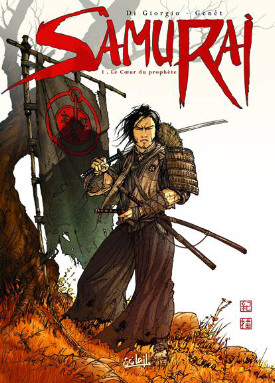Samurai vol.1: Le Coeur du prophète
By Patrick Bérubé
July 31, 2008 - 19:30
Soleil Productions
Writer(s): Jean-François Di Giorgio
Penciller(s): Frédéric Genêt
Inker(s): Frédéric Genêt
Colourist(s): Delphine Rieu
Cover Artist(s): Frédéric Genêt
12,90 Euros
 |
Di Giorgion cleverly intertwines historical facts with mythology and fiction. The setting is clearly feudal Japan but the presence of mystical elements, even if they are not directly shown, creates a rich and interesting backdrop for the story. You never actually know if the plot will stick to reality or wander into fantasy, which left me expecting anything for throughout the comic book. This pleasure was further helped by the momentum the story gains early on by alternating between the present events and the samurai's past. Much of the characters' development is put aside except for him in this first volume. We are instead, threatened with action scenes and samurai's philosophy, which worked well for me. All the other characters easily blend in this setting. The only downside to all of this is that this comic book will not reinvent the genre. It sticks to the conventions of samurai stories (honor, combat-style, quest for missing relative, etc) a bit too much.
The art is perfectly suited for the genre of story told here. The clean and sometime loose pencil of Genêt is realistic and help establish the mood and the context of the era. Only the depiction of the various characters is a bit less detailed but it somehow helps them to be more credible. His page layout, even if it is not spectacular, add a nice touch of dynamism to the various events. The "sliced" panel of the sword fight between the samurai and a group of ninjas was probably my favourite. As for the color, I would say that it is appropriate but not especially outstanding. A lot of pale tones are used, and I would sometimes have appreciated more bright colors. But then again, maybe it's the historical setting that is imposing such a choice.
Overall, it is a solid read for a mainstream European comic book, even if it sticks to traditional ground. Everything is well done and there is no major flaw in any aspect of this comic book. It's also nice to read a samurai story that does not seem to be influenced by manga but rather by our historical perception of feudal Japan and its mythology.
I rate this comic book 8 out of 10
Related Articles:
European Comics: An Industry in Despair
Binquirer May 14 2014 - Wayward, European Comics and Gambit Movie
Some European Comics Suitable For kids
America’s Portrayal in European Comic Books
A Guide to European Comic Book Publishers Part 4: Soleil Productions
European Comics You Should Read
A guide to european comic book publishers part 3: l'Association
A Guide To European Comic Book Publishers Part 2: Les Humanoïdes Associés
A Guide To European Comic Book Publishers Part 1: Casterman
Original European comic art auction sets new record
